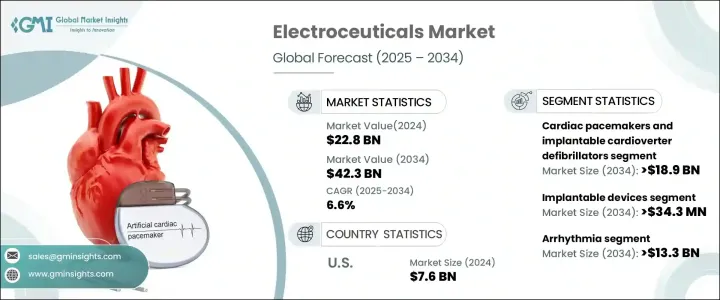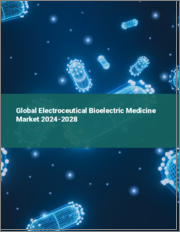
|
시장보고서
상품코드
1698281
전기의료 시장 : 시장 기회, 성장 촉진요인, 산업 동향 분석, 예측(2025-2034년)Electroceuticals Market Opportunity, Growth Drivers, Industry Trend Analysis, and Forecast 2025-2034 |
||||||
세계의 전기의료 시장은 2024년에 228억 달러로 평가되었으며, 2025-2034년 CAGR 6.6%를 나타낼 것으로 예측됩니다.
이 시장은 바이오 전자의료 기술 진보, 만성 질환 증가, 비약물 대체 치료에 대한 수요 증가가 원동력이 되어 대폭적인 확대를 이루고 있습니다. 전기 자극을 이용해 병세를 치료하는 전기의료는 기존 의약품에 비해 부작용이 적고 보다 효과적이며 저침습적인 치료법을 환자나 헬스케어 공급자가 찾게 되면서 널리 주목을 받고 있습니다. 심혈관 질환, 신경 질환, 통증 관리와 같은 만성 질환의 부담이 증대하고 있는 것이, 이러한 기기에 대한 관심을 높이고 있습니다. 헬스케어 산업이 보다 환자 중심의 치료로 전환되는 가운데, 전기의료는 최신의 치료 접근법의 중요한 요소로서 대두되고 있습니다.

바이오 전자의료 기술 혁신은 보다 효율적이고 정밀한 전기의료 장비의 개발을 가능하게 하고, 시장 성장을 더욱 촉진하고 있습니다. 연구 투자 증가 및 유리한 규제 정책은 제조업체에 제품 포트폴리오 확대를 촉구하고 있습니다. 게다가 비침습적인 치료 옵션에 대한 소비자 의식의 고조와 헬스케어 솔루션에 대한 액세스 향상이, 채용율을 끌어올리고 있습니다. 인공지능 및 스마트 모니터링 기능의 통합으로 전기의료 기기는 보다 개별화되고 장기적인 상태 관리에 효과적이 되고 있습니다. 시장은 또한 의료 기술 기업과 연구 기관의 공동 연구로부터 혜택을 받고 있으며, 기기의 소형화, 무선 통신, 배터리 수명의 개선에 있어서의 돌파를 뒷받침하고 있습니다.
| 시장 범위 | |
|---|---|
| 시작 연도 | 2024년 |
| 예측 연도 | 2025-2034년 |
| 시작 금액 | 228억 달러 |
| 예측 금액 | 423억 달러 |
| CAGR | 6.6% |
시장은 심장 장치, 신경 조절제, 임플란트 등 제품 카테고리에 따라 분류됩니다. 페이스메이커 및 제세동기를 포함한 심장기기는 CAGR 6.7%로 가장 높은 성장이 전망되며, 2034년에는 189억 달러에 달할 것으로 예측됩니다. 심혈관 질환의 유병률 증가 및 세계 인구의 고령화가 이러한 구명 기기에 대한 수요를 촉진하고 있습니다. MRI 대응 페이스 메이커나 원격 환자 모니터링 시스템 등 심장 기술의 지속적인 개선으로 이러한 솔루션은 보다 효과적이고 이용하기 쉬워지고 있습니다. AI를 활용한 진단 및 실시간 건강 추적의 통합으로 임상 현장에서의 채용이 더욱 진행되고 있습니다.
전기의료 시장은 또한 임베디드 디바이스와 비침습형 디바이스로 분류됩니다. 임베디드 디바이스 분야는 CAGR 6.3%로 성장해 2034년까지 343억 달러에 이를 것으로 예측되고 있습니다. 만성질환 증가 및 바이오 전자의료의 진보가 주요한 성장 촉진 요인입니다. 척수자극 장치나 인공와우와 같은 임베디드 전기의료는 지속적인 투약 없이 상태를 관리하는 장기적인 솔루션을 제공해 환자와 헬스케어 제공자 모두에게 매력적인 선택지가 되고 있습니다.
미국의 전기의료 시장은 2024년 76억 달러를 창출했으며, 2025-2034년 연평균 복합 성장률(CAGR) 5.7%로 성장할 것으로 예상됩니다. 만성 질환, 특히 심혈관 질환 및 신경 질환 유병률 증가가 전기의료 솔루션의 수요를 촉진하고 있습니다. 급속한 고령화 및 의료기술의 끊임없는 진보가 시장의 성장을 더욱 뒷받침하고 있습니다. 페이스메이커, 뇌심부자극장치, 기타 전기의료 장치는 만성동통, 심장질환, 신경질환의 치료에 있어서 그 유효성이 증명되고 있기 때문에 높은 수요가 있습니다. 헬스케어 인프라가 강화되고 상환 정책이 보다 유리해짐에 따라 미국의 전기의료 시장은 지속적으로 확대될 태세를 갖추고 있습니다.
목차
제1장 조사 방법 및 조사 범위
제2장 주요 요약
제3장 업계 인사이트
- 생태계 분석
- 업계에 미치는 영향요인
- 성장 촉진요인
- 바이오 일렉트로닉스 및 신경 자극 기술의 진보
- 저침습 절차의 채용 증가
- 통증 관리 솔루션에 대한 수요 증가
- 신경 질환 및 정신 질환에 대한 용도 확대
- 생체전기의학 연구에 대한 투자 증가
- 업계의 잠재적 위험 및 과제
- 전기의료 기기의 고비용
- 기기 오작동 위험 및 안전에 대한 우려
- 대체 치료 옵션의 가용성
- 성장 촉진요인
- 성장 가능성 분석
- 규제 상황
- 기술 상황
- 갭 분석
- Porter's Five Forces 분석
- PESTEL 분석
- 향후 시장 동향
- 밸류체인 분석
- 정밀 치료를 향하는 임상 주도형 스마트 임베디드 전자 기기의 개요
제4장 경쟁 구도
- 서문
- 기업 매트릭스 분석
- 기업 점유율 분석
- 주요 시장 기업의 경쟁 분석
- 경쟁 포지셔닝 매트릭스
- 전략 대시보드
제5장 시장 추계 및 예측 : 제품별(2021-2034년)
- 주요 동향
- 심장 페이스메이커 및 이식형 제세동기
- 신경조절기
- 척수 자극 장치
- 뇌심부 자극 장치
- 미주 신경 자극 장치
- 천골 신경 자극 장치
- 위 전기 자극 장치
- 경피 전기 신경 자극 장치
- 경두개 자기 자극기
- 기타 신경조절기
- 인공 내이
- 망막 이식
제6장 시장 추계 및 예측 : 유형별(2021-2034년)
- 주요 동향
- 내장형 디바이스
- 비침습성 디바이스
제7장 시장 추계 및 예측 : 용도별(2021-2034년)
- 주요 동향
- 부정맥
- 만성 통증 관리
- 신경질환
- 난청
- 파킨슨병
- 요실금
- 기타 용도
제8장 시장 추계 및 예측 : 최종 용도별(2021-2034년)
- 주요 동향
- 병원 및 진료소
- 외래수술센터(ASCs)
- 기타 최종 용도
제9장 시장 추계 및 예측 : 지역별(2021-2034년)
- 주요 동향
- 북미
- 미국
- 캐나다
- 유럽
- 독일
- 영국
- 프랑스
- 스페인
- 이탈리아
- 네덜란드
- 아시아태평양
- 중국
- 일본
- 인도
- 호주
- 한국
- 라틴아메리카
- 브라질
- 멕시코
- 아르헨티나
- 중동 및 아프리카
- 남아프리카
- 사우디아라비아
- 아랍에미리트(UAE)
제10장 기업 프로파일
- Abbott
- Axonics
- BIOTRONIK
- Boston Scientific
- Cala Health
- Cochlear
- LivaNova
- Medico SpA
- Medtronic
- MicroPort
- Monarch
- NEUROPACE
- Nevro
- Nurotron
- SetPoint Medical
- Sky Medical Technology
- SONOVA
The Global Electroceuticals Market was valued at USD 22.8 billion in 2024 and is projected to grow at a CAGR of 6.6% between 2025 and 2034. The market is witnessing significant expansion, driven by technological advancements in bioelectronic medicine, increasing prevalence of chronic diseases, and rising demand for non-drug treatment alternatives. Electroceuticals, which leverage electrical stimulation to treat medical conditions, are gaining widespread attention as patients and healthcare providers seek more effective, minimally invasive therapies with fewer side effects compared to traditional pharmaceuticals. The growing burden of chronic conditions such as cardiovascular diseases, neurological disorders, and pain management challenges has fueled interest in these devices. As the healthcare industry shifts towards more patient-centric care, electroceuticals are emerging as a critical component of modern treatment approaches.

Innovations in bioelectronic medicine are enabling the development of more efficient and precise electroceutical devices, further propelling market growth. Increasing research investments and favorable regulatory policies are encouraging manufacturers to expand their product portfolios. Moreover, rising consumer awareness about non-invasive treatment options and improved accessibility to healthcare solutions are boosting adoption rates. With the integration of artificial intelligence and smart monitoring capabilities, electroceutical devices are becoming more personalized and effective in managing long-term conditions. The market is also benefiting from collaborations between medtech companies and research institutions, driving breakthroughs in device miniaturization, wireless communication, and battery life improvements.
| Market Scope | |
|---|---|
| Start Year | 2024 |
| Forecast Year | 2025-2034 |
| Start Value | $22.8 Billion |
| Forecast Value | $42.3 Billion |
| CAGR | 6.6% |
The market is segmented based on product categories, including cardiac devices, neuromodulators, and implants. Cardiac devices, which include pacemakers and defibrillators, are expected to experience the highest growth, with a CAGR of 6.7%, reaching USD 18.9 billion by 2034. The increasing prevalence of cardiovascular diseases, coupled with an aging global population, is driving demand for these life-saving devices. Continuous improvements in cardiac technologies, such as MRI-compatible pacemakers and remote patient monitoring systems, are making these solutions more effective and accessible. The integration of AI-powered diagnostics and real-time health tracking is further enhancing their adoption in clinical settings.
The electroceuticals market is also classified into implantable and non-invasive devices. The implantable devices segment is projected to reach USD 34.3 billion by 2034, growing at a CAGR of 6.3%. Rising incidences of chronic diseases and ongoing advancements in bioelectronic medicine are key growth drivers. Implantable electroceuticals, such as spinal cord stimulators and cochlear implants, offer long-term solutions for managing conditions without continuous medication use, making them an attractive option for both patients and healthcare providers.
U.S. Electroceuticals Market generated USD 7.6 billion in 2024 and is forecasted to grow at a CAGR of 5.7% between 2025 and 2034. The increasing prevalence of chronic diseases, particularly cardiovascular and neurological disorders, is fueling demand for electroceutical solutions. A rapidly aging population and continuous advancements in medical technology are further supporting market growth. Pacemakers, deep brain stimulators, and other electroceutical devices are in high demand due to their proven efficacy in treating chronic pain, heart conditions, and neurological disorders. As healthcare infrastructure strengthens and reimbursement policies become more favorable, the U.S. electroceuticals market is poised for sustained expansion.
Table of Contents
Chapter 1 Methodology and Scope
- 1.1 Market scope and definitions
- 1.2 Research design
- 1.2.1 Research approach
- 1.2.2 Data collection methods
- 1.3 Base estimates and calculations
- 1.3.1 Base year calculation
- 1.3.2 Key trends for market estimation
- 1.4 Forecast model
- 1.5 Primary research and validation
- 1.5.1 Primary sources
- 1.5.2 Data mining sources
Chapter 2 Executive Summary
- 2.1 Industry 3600 synopsis
Chapter 3 Industry Insights
- 3.1 Industry ecosystem analysis
- 3.2 Industry impact forces
- 3.2.1 Growth drivers
- 3.2.1.1 Advancements in bioelectronics and neurostimulation technologies
- 3.2.1.2 Increasing adoption of minimally invasive procedures
- 3.2.1.3 Rising demand for pain management solutions
- 3.2.1.4 Expansion of applications in neurological and psychiatric disorders
- 3.2.1.5 Growing investments in bioelectric medicine research
- 3.2.2 Industry pitfalls and challenges
- 3.2.2.1 High cost of electroceutical devices
- 3.2.2.2 Risk of device malfunction and safety concerns
- 3.2.2.3 Availability of alternative treatment options
- 3.2.1 Growth drivers
- 3.3 Growth potential analysis
- 3.4 Regulatory landscape
- 3.5 Technology landscape
- 3.6 Gap analysis
- 3.7 Porter's analysis
- 3.8 PESTEL analysis
- 3.9 Future market trends
- 3.10 Value chain analysis
- 3.11 Overview on clinically driven smart implantable electronic devices moving towards precision therapy
Chapter 4 Competitive Landscape, 2024
- 4.1 Introduction
- 4.2 Company matrix analysis
- 4.3 Company market share analysis
- 4.4 Competitive analysis of major market players
- 4.5 Competitive positioning matrix
- 4.6 Strategy dashboard
Chapter 5 Market Estimates and Forecast, By Product, 2021 - 2034 ($ Mn)
- 5.1 Key trends
- 5.2 Cardiac pacemakers and implantable cardioverter defibrillators
- 5.3 Neuromodulators
- 5.3.1 Spinal cord stimulators
- 5.3.2 Deep brain stimulators
- 5.3.3 Vagus nerve stimulators
- 5.3.4 Sacral nerve stimulators
- 5.3.5 Gastric electrical stimulators
- 5.3.6 Transcutaneous electrical nerve stimulators
- 5.3.7 Transcranial magnetic stimulators
- 5.3.8 Other neuromodulators
- 5.4 Cochlear implants
- 5.5 Retinal implants
Chapter 6 Market Estimates and Forecast, By Type, 2021 - 2034 ($ Mn)
- 6.1 Key trends
- 6.2 Implantable devices
- 6.3 Non-invasive devices
Chapter 7 Market Estimates and Forecast, By Application, 2021 - 2034 ($ Mn)
- 7.1 Key trends
- 7.2 Arrhythmia
- 7.3 Chronic pain management
- 7.4 Neurological disorders
- 7.5 Hearing loss
- 7.6 Parkinson's disease
- 7.7 Urine incontinence
- 7.8 Other applications
Chapter 8 Market Estimates and Forecast, By End Use, 2021 - 2034 ($ Mn)
- 8.1 Key trends
- 8.2 Hospitals and clinics
- 8.3 Ambulatory surgical centers (ASCs)
- 8.4 Other end use
Chapter 9 Market Estimates and Forecast, By Region, 2021 - 2034 ($ Mn)
- 9.1 Key trends
- 9.2 North America
- 9.2.1 U.S.
- 9.2.2 Canada
- 9.3 Europe
- 9.3.1 Germany
- 9.3.2 UK
- 9.3.3 France
- 9.3.4 Spain
- 9.3.5 Italy
- 9.3.6 Netherlands
- 9.4 Asia Pacific
- 9.4.1 China
- 9.4.2 Japan
- 9.4.3 India
- 9.4.4 Australia
- 9.4.5 South Korea
- 9.5 Latin America
- 9.5.1 Brazil
- 9.5.2 Mexico
- 9.5.3 Argentina
- 9.6 Middle East and Africa
- 9.6.1 South Africa
- 9.6.2 Saudi Arabia
- 9.6.3 UAE
Chapter 10 Company Profiles
- 10.1 Abbott
- 10.2 Axonics
- 10.3 BIOTRONIK
- 10.4 Boston Scientific
- 10.5 Cala Health
- 10.6 Cochlear
- 10.7 LivaNova
- 10.8 Medico S.p.A.
- 10.9 Medtronic
- 10.10 MicroPort
- 10.11 Monarch
- 10.12 NEUROPACE
- 10.13 Nevro
- 10.14 Nurotron
- 10.15 SetPoint Medical
- 10.16 Sky Medical Technology
- 10.17 SONOVA



















